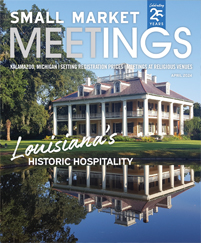The Lyceum
Hartford, Connecticut
In 1895, the Archdiocese of Hartford started construction on a building in Hartford, Connecticut, that would serve as a wholesome gathering place for young men, naming it The Lyceum. The stately, three-story brick building has had many incarnations over the decades, housing a box company, a community center, a hot-air-balloon manufacturer, a punk rock club and a roller-skating business.
In 2003, the Melville Charitable Trust renovated the building to serve as a conference center, and all the money it raises goes to the Partnership for Strong Communities. So when groups reserve the space, “you’re actually paying to make a donation to expand affordable housing and end homelessness,” said Jane Peters, events and building manager with Partnership for Strong Communities.
The main conference space, in the former auditorium, can seat 170 people theater style and has a stage with two balconies flanking the room. The space reopens this month following a renovation that included new flooring and added a new rental space. The former reference library across the hall was underused, but it’s now available for events for 80 to 100 people. With original wood ceilings and stunning windows, “it’s my favorite room in the building,” Peters said. The Lyceum also has two additional conference rooms for 10 to 20 people.
The center’s preferred caterer is the Kitchen at Billings Forge across the street, which provides on-the-job training and workforce development; it also offers cooking classes for groups.
Portland Masonic Temple
Portland, Maine
The Portland Masonic Temple was built in 1911, but it was only a few years ago that the Masonic Trustees of Portland opened some of the spaces to the public as event venues.
The six-story building sits in the heart of downtown Portland, Maine. Behind the gray brick-and-stone facade, visitors will find impressive interiors filled with period millwork; painted plaster; original stained-glass windows; antique chandeliers; and extensive scagliola, a 17th-century plaster technique that creates a marblelike finish on walls and floors.
The first floor features two function spaces. The Scottish Rite Reading Room works well for cocktail parties, with its antique wood paneling, Masonic portraits, a large fireplace, and original pool and snooker tables. Down the hall, 20-foot-tall doors open into the Armory, where up to 200 dinner guests will find hundreds of wooden Masonic Regalia lockers and an original stained-glass window that depicts the Knights Templar.
On the second floor, Boody Hall works for 50-person gatherings. The 4,000-square-foot Corinthian Hall can seat up to 200 people and features Corinthian columns, a 20-foot stained-glass window and one of the largest working pipe organs in Maine.











